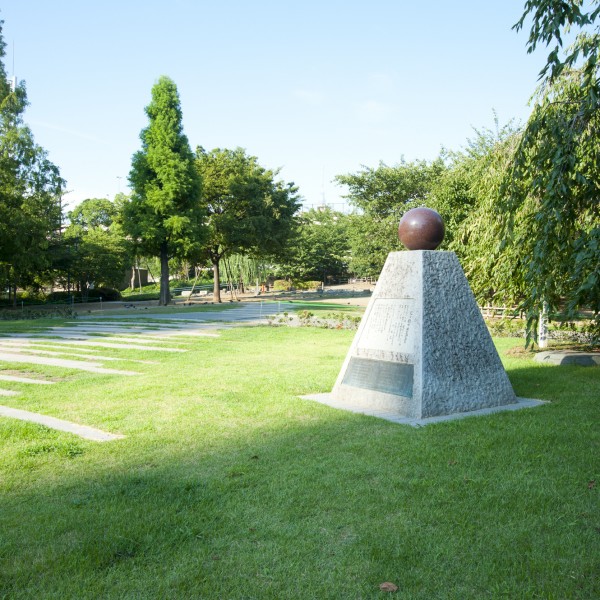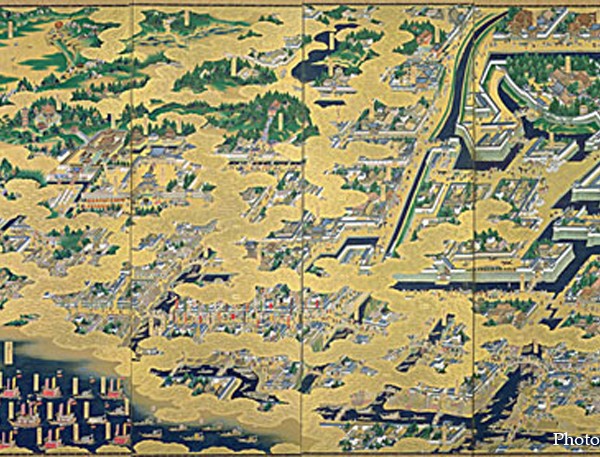- HOME >
- History of Nihombashi >
- Promoting the development・・・
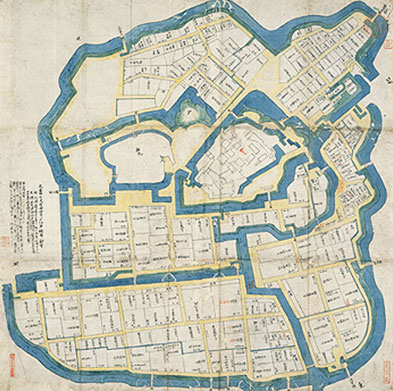
Promoting the development of Edo – major urban planning in the seventeenth century
Edo around 1608
When Ieyasu Tokugawa took over the government at the end of the sixteenth century, Edo was not fit for Ieyasu and his many retainers as there was only the Edo Castle, which had been there since the medieval times in 1457, and the war-torn area around the castle, seaport settlements, and nearby villages. Ieyasu first got to work on expanding the castle. He had a waterway opened so that building materials and rice in storage could be shipped directly by boat from Edo Bay to the castle and filled the cove of Hibiya with soil dug out for the moat around the castle. He then had the residences of his retainers established around the castle. Next, he divided the land of the main towns along the roads from east of the Tokiwabashi Gate towards Asakusa. The “main towns” refer to towns at the root of Edo where merchants lived, with roads of about 12 meters in width and areas of about 120 square meters each. Residences of people such as the gold guild members and the town elders were also established along these main towns.
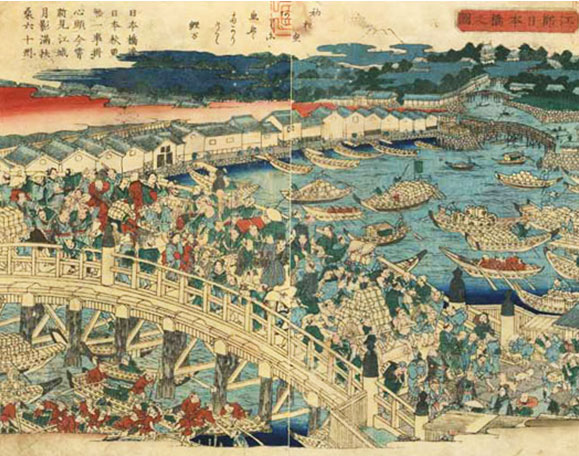
Upon becoming the shogun and establishing the shogunate in 1603, Ieyasu started full-scale urban development projects to make Edo the center of politics, economics, and culture in Japan. These projects were known as “Tenka Bushin”, and included the requirement for daimyos across the country to cooperate by providing resources. The daimyos in Western Japan were mostly ordered to provide ten workers per territory worth a thousand koku (a measurement of rice). This system was known as “Sengokufu”. Kadoyama was sapped and lowland swamps such as sand reefs and tidelands were filled in as the vast urban areas from Hamacho to Shinbashi were developed. The Nihombashi Bridge was built when the Nihombashi River was created during these works as the waterways for expanding the castle were extended eastward. In 1604, the Nihombashi Bridge became the starting point for five roads. Villages including Takaradamura and Chiyodamura that were on the castle premises or in locations such as in front of the former castle gate were transferred to other nearby locations along with temples and shrines such as Hirakawa Tenjin Shrine, Sanno-sha Shrine, Kanda Myojin Shrine, and Nichirin-ji Temple due to the extension work that was being done on the castle.
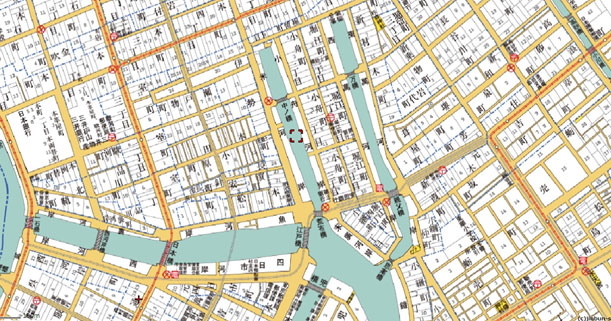
In addition to this newly-developed land becoming a place for the residences of important figures such as daimyos and direct retainers and alternative sites for the transferred temples and shrines, busy streets that passed through Shinbashi, Kyobashi, Nihombashi, and Kanda, north and south of the Nihombashi Bridge, were formed along with the establishing of habitable towns along these streets. The area north and south of the Nihombashi Bridge from Toricho and Muromachi to Kanda already had the Honcho Dori Street and was heavily populated with merchants and craftsmen from various regions. It eventually became an area for procuring items and workmen needed by the shogunate and daimyos and was called “shitamachi” (downtown) compared with the uptown neighborhoods of samurai homes. The towns of Edo that were established then were named after feudal domains; with names such as Surugacho, Owaricho, Kagacho, and Inabacho. They bore the names of the domains that the daimyos in charge of rebuilding the towns were from. Towns such as Zaimokucho, Honkokucho, Teppocho, Honkawayacho, Kanefukicho, Konyacho, and Okecho were named so because of the merchants and craftsmen that served the shogunate who lived there.
The end of the initial stage of turning Edo into the dominant castle town of Japan came in 1640, but Edo was also given the features of a military city. Images of what the streets of Edo were like can be seen in works such as the “Edo-zu Byobu” (Folding Screens of the Scenery of Edo), which are kept by the National Museum of Japanese History.
A fundamental change in this reform project of Edo took place when the Great Fire of Meireki struck in 1657. The fire destroyed about sixty percent of the city of Edo, and this made the shogunate decide to alter its plans into making Edo a leading city in fire prevention. Efforts such as the widening of roads, the creating of riverbanks for fire safety, the building of the Ryogokubashi Bridge spanning from the heart of the city to the east bank of Sumida River, landfills in the Tsukiji area, the laying of wide streets in Ryogoku and Nihombashi, the relocating of the residences of daimyos and retainers, and the moving of temples and shrines to surrounding locations went underway. This is how the urban areas of Edo were greatly expanded and underwent developments to join and become a city of a million people as of the eighteenth century.
